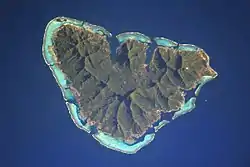
.jpg.webp)
Geologically, a volcanic island is an island of volcanic origin. The term high island can be used to distinguish such islands from low islands, which are formed from sedimentation or the uplifting of coral reefs[1] (which have often formed on sunken volcanos).
Definition and origin
There are a number of volcanic islands that rise no more than 1 metre (3 ft 3 in) above sea level, often classified as "islets or rocks", while some low islands, such as Banaba, Henderson Island, Makatea, Nauru, and Niue, as uplifted coral islands, rise over 50 metres (160 ft) above sea level.
The two types of islands are often found in proximity to each other, especially among the islands of the South Pacific Ocean, where low islands are found on the fringing reefs that surround most volcanic islands. Volcanic islands normally arise above a hotspot.
Habitability
The size of volcanic islands usually ranges between 1 and 104 square kilometres (0.4 and 40 sq mi). [2] Volcanic islands above a certain size usually have fresh groundwater, while low islands often do not, so volcanic islands are more likely to be habitable.
Many volcanic islands emerge from the deep abyss of the ocean, featuring rough or mountainous landscapes in their interiors and displaying a diverse array of summit elevations. Researches observed that the island will often be covered by dense tropical forest. The forests limit the use of the lands for settlement on many islands, therefore Communities, roads and houses were limited to develop along the coaster margin, as a result suffering from coastal hazards.[3] On larger islands rivers can flow, resulting in flood hazards and delivering sediment, which can dominate coastal morphology. Tall volcanic islands are often surrounded by protective fringing or barrier reefs, creating lagoons.[3]
See also
- Archipelagic apron – Fan-shaped gently sloping region of sea floor found around oceanic islands
- Atoll – Ring-shaped coral reef
- Canary Islands – Spanish archipelago and region in the Atlantic Ocean
- Galápagos Islands – Ecuadorean archipelago and protected area
- Guyot – Isolated, flat-topped underwater volcano mountain
- Krakatoa Archipelago – Archipelago of volcanic islands in Indonesia
- Seamount – Mountain rising from the ocean seafloor that does not reach to the water's surface
- Submarine landslide – Landslides that transport sediment across the continental shelf and into the deep ocean
- Volcanic arc – Chain of volcanoes formed above a subducting plate
References
- ↑ Murphy, Raymond E. (July 1949). ""High" and "Low" Islands in the Eastern Carolines". Geographical Review. American Geographical Society. 39 (3): 425–439. doi:10.2307/210643. JSTOR 210643.
- ↑ Condie, Kent C. (2022-01-01), Condie, Kent C. (ed.), "Chapter 2 - The crust", Earth as an Evolving Planetary System (Fourth Edition), Academic Press, pp. 9–37, ISBN 978-0-12-819914-5, retrieved 2023-12-28
- 1 2 Velmurugan, Ayyam (2008-01-01), Sivaperuman, Chandrakasan; Velmurugan, Ayyam; Singh, Awnindra Kumar; Jaisankar, Iyyappan (eds.), "Chapter 1 - The Nature and Characters of Tropical Islands", Biodiversity and Climate Change Adaptation in Tropical Islands, Academic Press, pp. 3–30, ISBN 978-0-12-813064-3, retrieved 2023-12-28
External links
- Micronesian culture: High island and low island cultures at Britannica.com. Retrieved 2011-09-22.